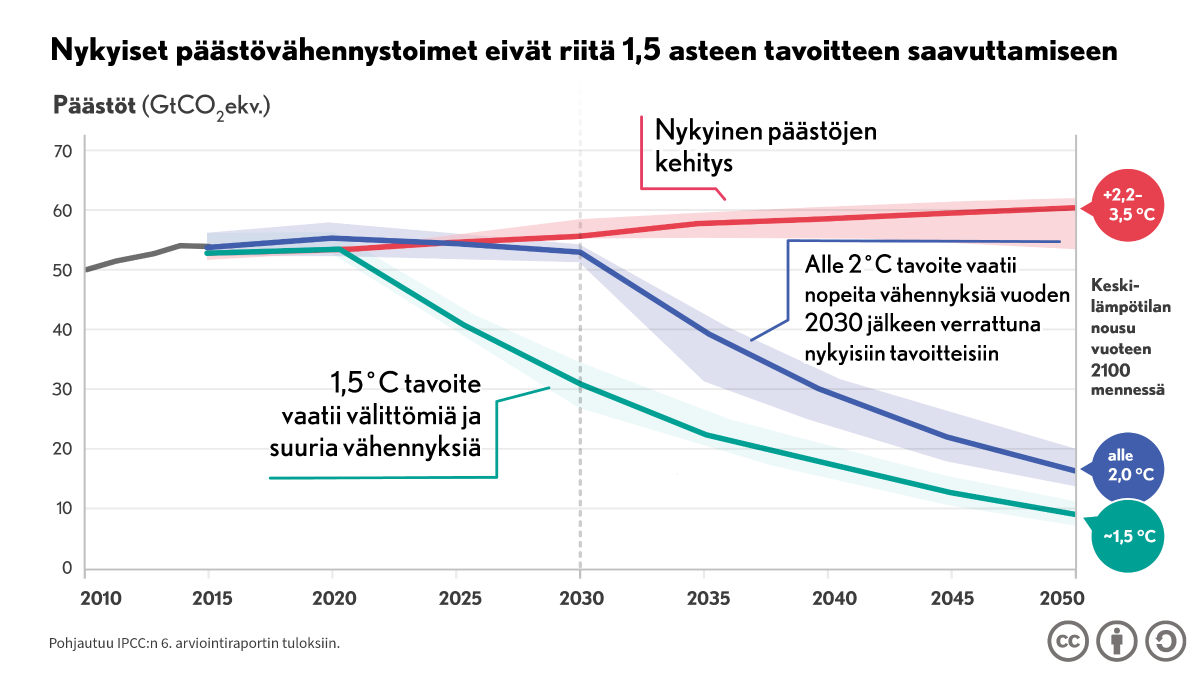IPCC report: Current actions not enough to limit warming to 1.5 degrees – effective emission reductions already needed during next decade

In its report published on 4 April, the Intergovernmental Panel on Climate Change (IPCC) points out that emission reduction measures must already be accelerated during the next decade to achieve international targets for limiting climate warming. Greenhouse gas emissions are growing in all sectors, and in the past decade the average GHG emissions were higher than ever before. The pace of growth in emissions has, however, slowed. The technological solutions needed to halve emissions from the 2019 level by 2030 already exist.
Press release of the Ministry of the Environment and VTT Technical Research Centre of Finland
According to the report, the climate targets announced by different states so far are not enough to limit climate warming to 1.5 degrees by the end of the century. With the climate actions that have been decided so far, climate warming will temporarily exceed the 1.5 degree limit, and strong emission reductions will be needed after 2030 to succeed in limiting the warming to less than 1.5–2 degrees.
The current trends in emissions will lead to a global warming of around three degrees by the end of the century unless fast and effective emission reduction measures are taken over the next two decades.
“Fossil energy has had a major role in causing climate change, and now the energy transformation offers the greatest opportunities to find solutions to climate change. The use of many types of low-emission technologies has become cheaper and they are being introduced faster,” says Antti Arasto, Vice President of VTT's research area Industrial energy and hydrogen.
The report stresses that limiting warming to 1.5 degrees or to no more than 2 degrees requires emission reduction measures in all sectors and major changes in the energy systems.
“The message of the report is extremely serious. The fate of our planet and its viability depend on how fast we can phase out fossil fuels. As the recent crises and the war in Ukraine have shown, energy transformation is no longer an absolute necessity just in terms of the climate but also for security reasons. There is a global need for faster means to boost the green transition. Sufficient funding for climate actions must also be secured,” says Minister of the Environment and Climate Change Emma Kari.
Emissions have grown in all sectors
Emissions are unevenly distributed between different parts of the world. These differences in emissions reflect regional differences and differences in income and development levels. Some countries have been able to combine greenhouse gas emissions reductions and economic growth, but at the same time, emissions have grown elsewhere in the world, leading to an increase at the global level. The most significant increase in emissions has taken place in Asia, while Europe’s share of net greenhouse gas emissions has declined in recent decades.
Emissions have grown in all sectors despite improvements in energy efficiency and the increased use of renewable energy. The main reasons for this are the growth of industry, energy distribution, transport, number of buildings and agriculture and changes in land use on the global scale.
According to the report, effective means to reduce emissions include improving the energy efficiency of buildings, using low-carbon construction materials and utilising renewable energy sources in heating and cooling In industry emission reductions can be achieved through new material technologies, production processes that use low-emission energy and carbon capture and storage.
Electrification of transport has the greatest potential to reduce emissions from passenger cars. In goods transport, maritime transport and aviation, the greatest emission reductions can be achieved with biofuels and low-emission fuels produced using hydrogen and electricity.
Mitigation measures promote Sustainable Development Goals
The report stresses that the climate change mitigation measures are a prerequisite for achieving sustainable development. The 17 UN Sustainable Development Goals aim to eradicate extreme poverty, and to take the environment, economy and people equally into account in sustainable development.
According to the report, mitigation measures promote the achievement of the most important Sustainable Development Goals, but they may also have adverse impacts on some of the goals. Mitigation measures may have both positive and negative impacts on e.g. employment and economic structures. The report considers it important that societies will ensure the fairness of mitigation measures.
The report stresses that many market and regulatory instruments we already have can be used to support effective emission reductions and promote innovation. Climate legislation and litigation may have increasingly positive impacts on climate-related decision-making in the future.
The IPCC report published on 4 April 2022 deals with climate change mitigation. The previous report on this was published in 2014. The report is Part 3 of the IPCC’s Sixth Assessment Report published in 2021–2022. Part 1 focused on the physical science basis of climate change and Part 2 dealt with the impacts of climate change and adaptation to it. The Synthesis Report to be published in autumn 2022 summarises the results of the three sub-reports.
Inquiries:
Emma Kari, Minister of the Environment and Climate Change; contacts: Milja Henttonen, Special Adviser, [email protected], tel. +358 50 599 3094
Antti Arasto, Vice President, Industrial energy and hydrogen, VTT, tel. +358 40 0159052, [email protected]
Laura Sokka, Senior Scientist, VTT, tel. +358 40 1879067, [email protected]
Kaarle Kupiainen, Senior Specialist, Ministry of the Environment, [email protected], tel. +358 29 525 0232
Heta-Elena Heiskanen, Senior Specialist, Ministry of the Environment, [email protected], tel. +358 295 250 380
The infographics based on the report are freely available to everyone (in Finnish; English and Swedish language versions will be available later)
Listaus valtionhallinnon sekä muiden organisaatioiden asiantuntijoita ilmastonmuutokseen hillinnän osa-alueelta
